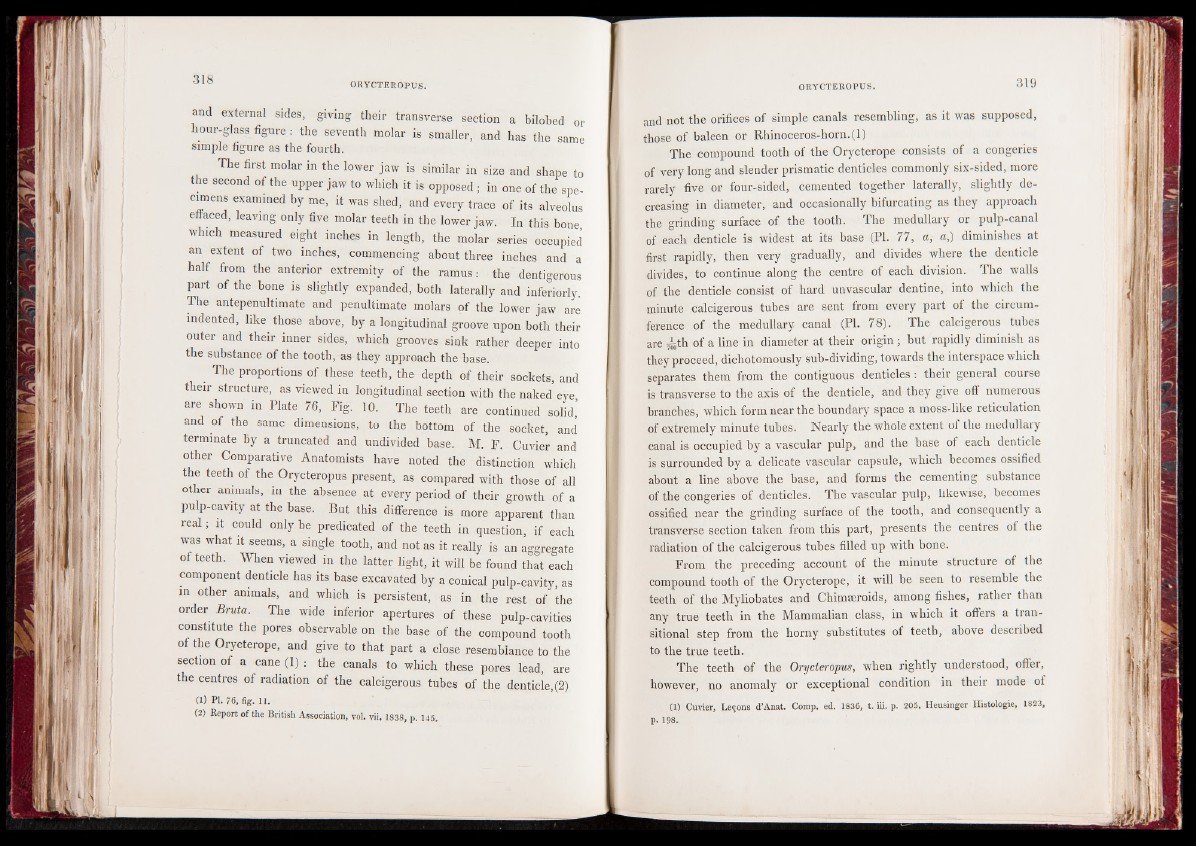
and external sides, giving their transverse section a bilobed or
hour-glass figure : the seventh molar is smaller, and has the same
simple figure as the fourth.
The first molar in the lower jaw is similar in size and shape to
the second of the upper jaw to which it is opposed ; in one of the specimens
examined by me, it was shed, and every trace of its alveolus
effaced, leaving only five molar teeth in the lower jaw. In this bone
which measured eight inches in length, the molar series occupied
an extent of two inches, commencing about three inches and a
half from the anterior extremity of the ramus: the dentigerous
part of the bone is slightly expanded, both laterally and inferiorly.
The antepenultimate and penultimate molars of the lower jaw are
indented, like those above, by a longitudinal groove upon both their
outer and their inner sides, which grooves sink rather deeper into
the substance of the tooth, as they approach the base.
The proportions of these teeth, the depth of their sockets, and
their structure, as viewed in longitudinal section with the naked eye
are shown in Plate 76, Figi 10. The teeth are continued solid,’
and of the same dimensions, to the bottom of the socket, and
terminate By a truncated and undivided base. M. F. Cuvier and
other Comparative Anatomists have noted the distinction which
the teeth of the Orycteropus present, as compared with those of all
other animals, in the absence at every period of their growth of a
pulp-cavity at the base. But this difference is more apparent than
real; it could only he predicated of the teeth in question, if each
was what it seems, a single tooth, and not as it really is an aggregate
of teeth. When viewed in the latter light, it will be found that each
component denticle has its base excavated by a conical pulp-cavity, as
in other animals, and which is persistent, as in the rest of the
order Bruta. The wide inferior apertures of these pulp-cavities
constitute the pores observable on the base of the compound tooth
of the Orycterope, and give to that part a close resemblance to the
section of a cane (1) : the canals to which these pores lead, are
the centres of radiation of the calcigerous tubes of the denticle, (2)
(1) PI. 76, fig. 11.
(2) Report of the British Association, voi. vii. 1838, p. 145.
and not the orifices of simple canals resembling, as it was supposed,
those of baleen or Rhinoceros-horn. (1)
The compound tooth of the Orycterope consists of a congeries
of very long and slender prismatic denticles commonly six-sided, more
rarely five or four-sided, cemented together laterally, slightly decreasing
in diameter, and occasionally bifurcating as they approach
the grinding surface of the tooth. The medullary or pulp-canal
of each denticle is widest at its base (PI. 77, a, a,) diminishes at
first rapidly, then very gradually, and divides where the denticle
divides, to continue along the centre of each division. The walls
of the denticle consist of hard unvascular dentine, into which the
minute calcigerous tubes are sent from every part of the circumference
of the medullary canal (PI. 78). The calcigerous tubes
are ^th of a line in diameter at their origin; but rapidly diminish as
they proceed, dichotomously sub-dividing, towards the interspace which
separates them from the contiguous denticles : their general course
is transverse to the axis of the denticle, and they give off numerous
branches, which form near the boundary space a moss-like reticulation
of extremely minute tubes. Nearly the whole extent of the medullary
canal is occupied by a vascular pulp, and the base of each denticle
is surrounded by a delicate vascular capsule, which becomes ossified
about a line above the base, and forms the cementing substance
of the congeries of denticles. The vascular pulp, likewise, becomes
ossified near the grinding surface of the tooth, and consequently a
transverse section taken from this part, presents the centres of the
radiation of the calcigerous tubes filled up with bone.
From the preceding account of the minute structure of the
compound tooth of the Orycterope, it 'will be seen to resemble the
teeth of the Myliobates and Chimseroids, among fishes, rather than
any true teeth in the Mammalian class, in which it offers a transitional
step from the horny substitutes of teeth, above described
to the true teeth.
The teeth of the Orycteropus, when rightly understood, offer,
however, no anomaly or exceptional condition in their mode of
(1) Cuvier, Lemons d’Anat. Comp. ed. 1836, t. iij. p. 205. Heusinger Histologie, 1823,
p. 198.